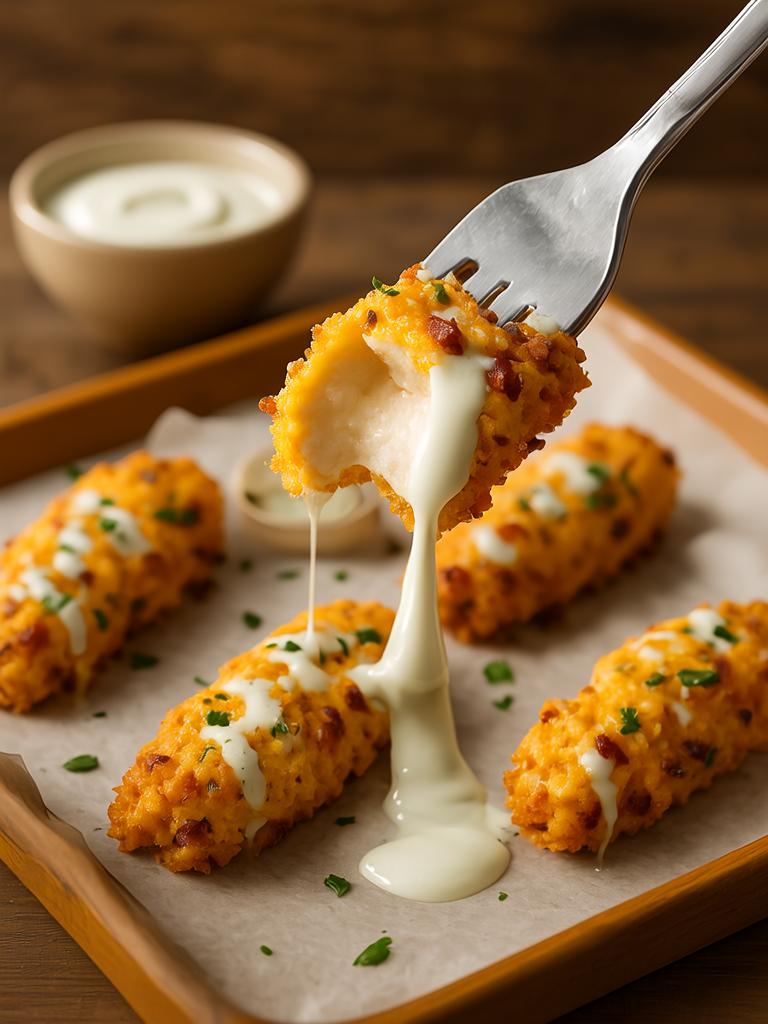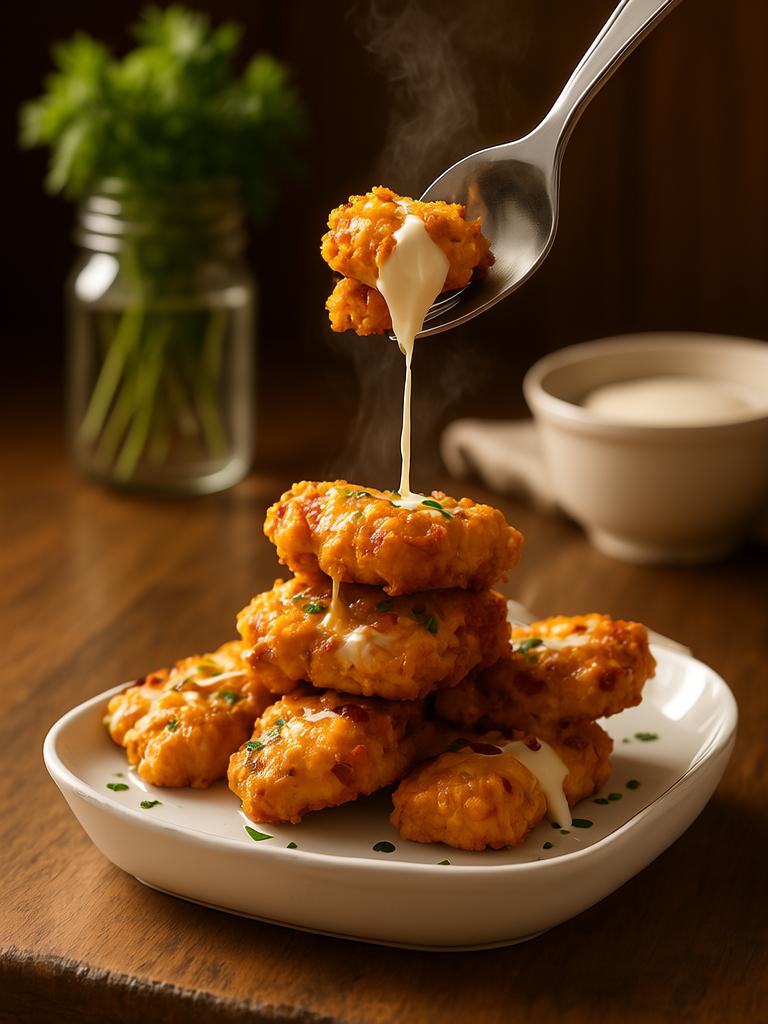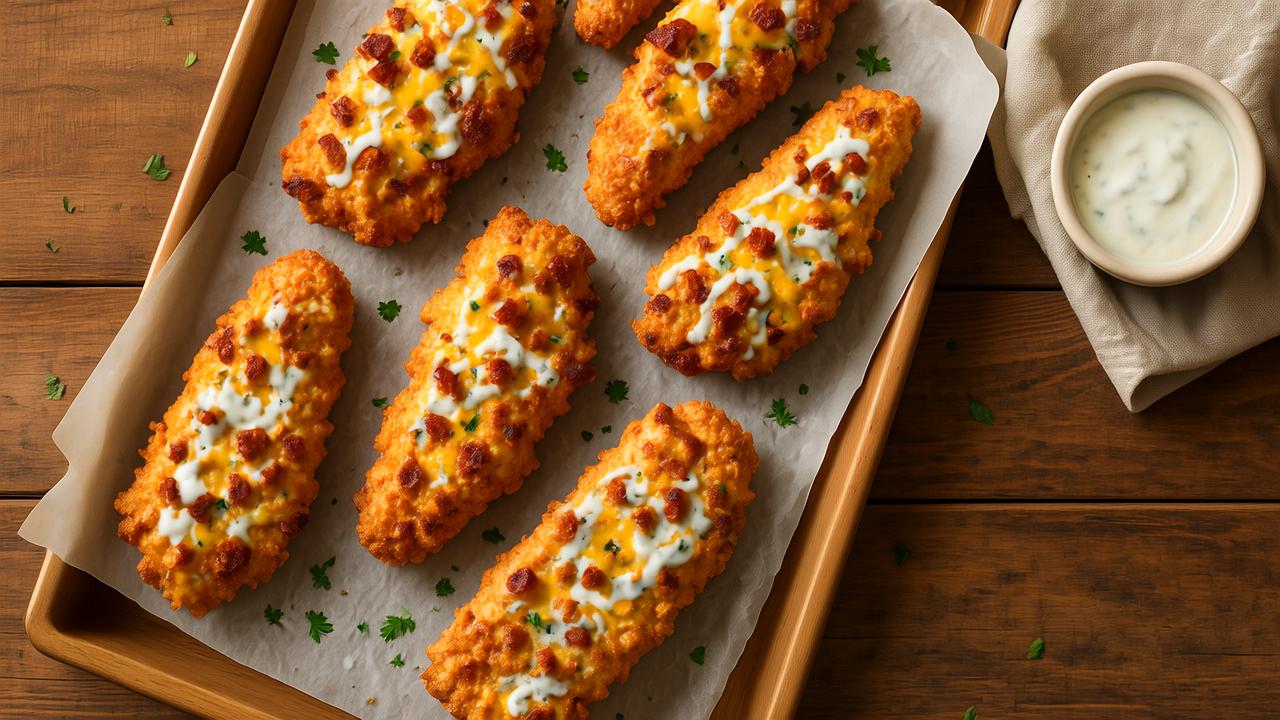Crack chicken tenders—yes, the name’s bold. But so is the flavor. We’re talking ultra-crispy, wildly juicy, and packed with that addictive blend of cheese, ranch, bacon, and just enough spice to make your tongue tap-dance.
At first glance, it might sound like a kitschy internet recipe made for viral reels. But don’t be fooled. Beneath the cheeky name lies a recipe that’s absolutely worth dissecting for serious cooks, caterers, food scientists—even restaurant pros. Why? Because these tenders combine elements of texture chemistry, crowd-pleasing flavor profiles, and smart culinary economics in a way that most “fun food” simply doesn’t.
Let’s rip this open and see what makes crack chicken tenders so damn good—and why you might want to be paying more attention to them.
What Exactly Are Crack Chicken Tenders?
To get it straight from the fryer—crack chicken tenders are typically boneless, skinless chicken breast strips, breaded or coated, baked or fried, and then tossed or layered with a combo of ranch seasoning, shredded cheddar cheese, cream cheese, crumbled bacon, and sometimes green onions.
Some versions bake it casserole-style. Others deep-fry then smother. Some go keto with no breading. It’s flexible. But the fundamentals? Always chicken + cheese + bacon + ranch = flavor bomb.
The “crack” isn’t about spice—it’s about how weirdly hard it is to stop eating ’em.
This isn’t just comfort food. It’s engineered comfort.
The Flavor Formula: Why It Works Every Time
Let’s break it down scientifically. There’s a reason crack chicken tenders make mouths water.
You’ve got umami from the cheese, salt + fat from the bacon, acid + herbs from ranch, and crisp + moist contrast from the chicken itself. That’s flavor layering 101.
- Salt-fat-acid-heat balance? Nailed.
- High-protein satisfaction? Yep.
- Nostalgia factor from ranch + bacon combo? That too.
According to a 2020 study from the Institute of Food Technologists (IFT), multi-layered sensory foods—those with contrast in taste and texture—are 74% more likely to trigger the brain’s reward system. That’s not just fluff. It’s brain science.
And the smell—oh, the smell. Bacon grease mingling with melty cheese on hot chicken? If you’ve ever run a food truck, you know exactly what that aroma cloud does to foot traffic.

Chicken Tender Texture Science (Because It Matters)
The tender itself? That’s your foundation. Get it wrong, and the whole thing collapses.
If you’re deep-frying, the moisture management becomes critical. You want a crispy exterior, but not at the expense of a dry center. Double-dipping in seasoned flour and buttermilk creates micro-layers that crisp beautifully while sealing in the juice.
Baking? Consider coating tenders in crushed pork rinds or seasoned panko mixed with parmesan. It crisps up with far less oil. Ideal for health-conscious menus.
Sous vide? Gamechanger. Pre-cook your tenders sous vide to 145°F, chill, then flash-fry for service. Perfectly cooked every time. No waste. Faster prep. Higher yield.
There’s a reason fine-dining kitchens have started embracing humble chicken tenders—it’s about execution, not elitism.
Let’s Talk Cheese: Not All Melts Are Equal
One of the biggest pro mistakes? Using the wrong cheese.
Crack chicken calls for meltability. Pre-shredded bagged cheddar has anti-caking agents that make it gritty when melted. You want to shred fresh. Or better—use a blend.
- 50% sharp cheddar (for tang)
- 25% Monterey Jack (for pull)
- 25% mozzarella (for stretch)
Cream cheese should be full-fat. No exceptions. Low-fat splits when heated and ruins the sauce texture.
Some chefs like to add a touch of cream or mayo to loosen things. If you’re scaling for catering, a béchamel base with cheddar folded in provides better consistency over long holding times.
Ranch: Homemade or Store?
This is where kitchens divide. Ranch seasoning packets are fast, cheap, consistent. But they also taste, well, artificial if you overdo it.
Making your own? Worth it. Mix:
- Buttermilk powder
- Dried dill
- Garlic + onion powder
- Black pepper
- Chives
- Touch of MSG (yep, we said it)
MSG in small amounts boosts that “can’t stop eating this” quality. And it’s safe. Period.
A fresh ranch dressing drizzle over hot tenders before serving? Yeah, chef’s kiss.

Bacon: Don’t Phone This Part In
Here’s where shortcuts go to die.
Don’t ever, ever use bacon bits from a jar. That’s plastic sadness.
You want thick-cut bacon, oven-cooked until crisp, then chopped. Not pulverized. Real pieces add chew, smoke, and that visual pop.
Pro tip: bake bacon on a rack above a sheet tray. Keeps it crisp. Saves the fat. (Which, by the way, you should brush on your tenders before baking. Adds insane flavor.)
Variations for the Pros
Once you master the base, you can riff in endless directions. Here’s where the pros shine:
- Buffalo Crack Tenders: Add Frank’s RedHot to the cheese mix. Top with blue cheese crumbles.
- Spicy Jalapeño Crack Tenders: Fold in pickled jalapeños and pepper jack. Serve with chipotle ranch.
- BBQ Crack Tenders: Swap ranch for smoky BBQ seasoning and sauce. Add a hint of brown sugar to the cheese.
- Crack Tender Sliders: Sandwich these suckers between mini brioche buns with coleslaw. Crowd pleaser? You bet.
Crack Tenders in Commercial Kitchens
Why should you care as a food professional?
- Low-cost protein
- High perceived value
- Endless customization
- Freezer-friendly
- Easy scaling
Restaurants report up to a 220% markup on chicken tenders in various forms. Add cheese + bacon + ranch, and you’ve got a $14 plate that costs under $3 to produce. That’s smart math.
Ghost kitchens thrive on crave-able, portable, reheat-able food. Crack tenders check every box.
And in catering? These hold well under warmers. Guests love them. No carving station needed.
Nutrition and Health Considerations
Okay, let’s not kid ourselves. Crack chicken tenders are indulgent.
But with small tweaks, you can reduce the guilt:
- Bake instead of fry
- Use reduced-fat cheese (if you must)
- Add shredded zucchini to the cheese mix (nobody notices)
- Serve with veggie sticks or salad to balance the plate
For keto clients? Skip the breading. Use almond flour or crushed pork rinds instead. It’s already a hit in low-carb communities.
Common Mistakes to Avoid
Even pros can fumble here. A few things to watch:
- Overcooking the chicken: Use a thermometer. Pull at 160°F, rest to 165°F.
- Cheese separation: Don’t overheat. Add cheese off the heat, stir gently.
- Using bad bacon: See above. Just… don’t.
- Going too salty: Ranch seasoning + bacon + cheese = sodium bomb. Balance with unsalted butter or cream to mellow.
Emerging Trend: Crack Chicken Goes Global
This American comfort staple is starting to globalize.
In Japan, they’re adding togarashi and yuzu aioli. In Mexico, chefs riff with chipotle crema and cotija. In the Middle East? Za’atar crack tenders with labneh ranch are gaining traction in fusion spots.
It’s not just food—it’s a format. A blank, craveable canvas.
Crack chicken tenders are quietly becoming the global grilled cheese of the protein world.
Final Thoughts: The Case for Crack Chicken Tenders
You could scoff. Write these off as internet food fluff. But that’d be missing the point.
Crack chicken tenders aren’t just a viral dish. They’re a perfect example of food that hits all five senses, all five flavors, and sells like wild.
For chefs, it’s a study in texture and contrast.
For caterers, it’s a scalable cash cow.
For restaurants, it’s that one dish no one returns.
And for eaters? It’s just damn good food. Ain’t nothing wrong with that.
So go ahead. Call it crack. Call it comfort. Call it chicken magic. But whatever you do—cook it right. Because when done right, these tenders are a quiet masterclass in how smart, addictive food should be made.
Now go melt some cheese on something. You know you want to.
FAQs
What are crack chicken tenders made of?
They’re chicken strips loaded with cheddar, bacon, ranch seasoning, and sometimes cream cheese—crispy, juicy, and addictive.
Why are they called “crack” chicken tenders?
Because they’re so flavorful and crave-worthy, people joke they’re addictive like crack.
Can I bake instead of fry crack chicken tenders?
Yes, baking works great—just coat them well and bake until golden and crisp.
Is there a keto version of crack chicken tenders?
Absolutely, just skip the breading or use crushed pork rinds or almond flour instead.
What’s the best cheese blend to use?
Use a mix of sharp cheddar, Monterey Jack, and mozzarella for flavor and melt.
How do I keep them from getting too salty?
Balance the ranch, bacon, and cheese with unsalted butter or mild cream cheese.
Can I make crack chicken tenders ahead of time?
Yes, prep and refrigerate or freeze, then bake or reheat before serving.
What’s the ideal internal temperature for cooked chicken tenders?
Cook them to 160°F, then rest to 165°F for safe and juicy results.
Are crack chicken tenders good for catering or food trucks?
Yes, they’re super popular, easy to scale, and hold up well during service.
How can I make them healthier?
Bake instead of fry, use reduced-fat cheese, and add veggies to the mix.
Can I use store-bought ranch seasoning?
You can, but homemade ranch seasoning gives better flavor and control.
What’s the best bacon to use?
Use thick-cut, oven-cooked bacon—not those sad, fake bacon bits.
Are crack chicken tenders kid-friendly?
Totally—they’re cheesy, crispy, and fun to eat, especially with dipping sauces.
Can I turn them into a sandwich or slider?
Yes, slap them in a bun with slaw or pickles for a killer slider.
How long can I store leftovers?
Keep them in the fridge for 3–4 days or freeze for up to 2 months.

Mariana is a passionate home cook who creates delicious, easy-to-follow recipes for busy people. From energizing breakfasts to satisfying dinners and indulgent desserts, her dishes are designed to fuel both your body and hustle.
When she’s not in the kitchen, she’s exploring new flavors and dreaming up her next recipe to share with the Foodie Hustle community.

